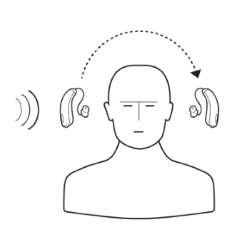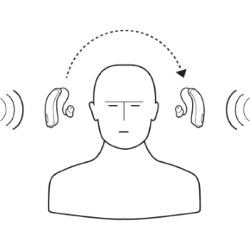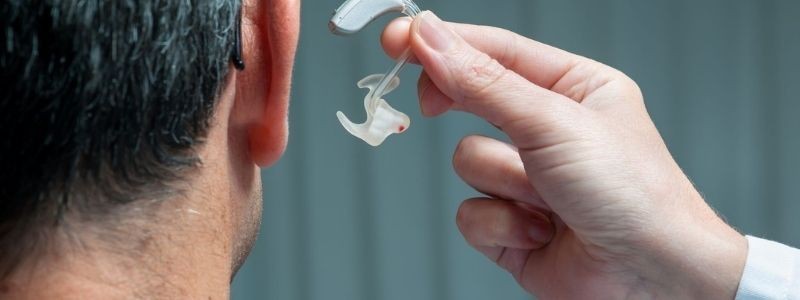Free home visits
with a local audiologist


CROS Hearing Solution BiCROS Hearing Solution
Single-sided deafness means you have one ear that is deaf and one ear with ‘normal’ hearing. This also applies to those who have one deaf ear and one who has hearing loss which can be improved by wearing a digital hearing aid. This is also called unilateral hearing loss.
Some individuals can not hear much in one ear to such an extent that a standard hearing aid won't support them. Unfortunately, some people with single-sided deafness live with it by asking people to communicate with them on their good side or their 'good' ear.
This isn't an ideal solution and means that they will still find it a challenge to hear in noisy environments as well as locate the direction of the sound they hear.
Now there are various successful hearing aid solutions that cater to single-sided deafness such as CROS and BiCROS hearing aids. We go into more detail about these latest models introduced into the industry further down the page.
Generic hearing aids direct sound into the ear they are placed on. With a CROS hearing solution, the device on the poor ear side looks like a generic hearing aid, but actually, it is a transmitter and microphone that picks up the sound to direct it to the device on the good side or ear that can hear.
So, what are CROS and BiCROS hearing aids - how do they work? There are two separate hearing aid solutions for single-sided deafness and these are called CROS hearing aids and BICROS hearing aids. Here is the breakdown:
What is a BiCROS hearing aid? A BiCROS hearing aid is for people who have one deaf ear and one ear with hearing loss. The abbreviation stands for Bilateral with Contra-lateral Routing of Signal.
BiCROS (bilateral contralateral routing of signals) hearing aids are a type of hearing device that is used to improve hearing in individuals with asymmetrical hearing loss or single-sided deafness (SSD). Asymmetrical hearing loss refers to a condition where an individual has a significant difference in hearing ability between the two ears.
SSD is a condition in which an individual has normal or near-normal hearing in one ear, but severe to profound hearing loss in the other ear.
BICROS hearing aids are similar to traditional hearing aids in that they are worn in both ears. However, the hearing aid in the poorer hearing ear is equipped with a microphone that picks up sounds from that ear and transmits them wirelessly to the hearing aid in the better-hearing ear.
This allows the individual to hear sounds from both ears, even if one ear is not functioning properly.
What is a CROS hearing aid? A CROS hearing aid is for people with one deaf ear and one good ear. The abbreviation stands for Contra-lateral Routing of Signal.
Cross hearing aids, also known as CROS or contralateral routing of signals hearing aids, are devices that are used to improve hearing in individuals with single-sided deafness (SSD) or asymmetrical hearing loss. With SSD, an individual has normal or near-normal hearing in one ear, but severe to profound hearing loss in the other ear.
Asymmetrical hearing loss refers to a condition where an individual has a significant difference in hearing ability between the two ears.
CROS hearing aids are designed to pick up sounds from the poorer-hearing ear and transmit them wirelessly to a hearing aid in the better-hearing ear. This allows the individual to hear sounds from both sides of their body and improves their ability to locate the source of a sound.
CROS hearing aids can be particularly helpful for individuals who have difficulty hearing in noisy environments, as they allow the individual to hear sounds from both sides of their body, which can improve their ability to focus on a conversation or other important sounds.
They can also be helpful for individuals who have trouble understanding speech when only one ear is functioning properly, as the CROS hearing aid allows them to hear sounds from both ears.

For those who are deaf in one ear, there are a few challenges. For example, following conversations (also known as the Head Shadow Effect) is a challenge because of the different sound frequencies we hear. For instance, low-frequency sounds are shorter in wavelength (which can go around the head) and high-frequency sounds are shorter (which are blocked by the head).
Therefore, it makes it extremely difficult for those with a deaf ear to follow the conversation – without having to turn their head. The direction of sound is also tricky, as having one good ear makes it very hard to know which direction sounds are coming from.
So, how do CROS hearing aids work? In brief, in a CROS system, you wear hearing aids in both ears – even though you can’t hear in one ear. This means the sound detected by the hearing aid in the bad ear is transmitted straight to the aid in the good ear. This eliminates the ‘head shadow’ effect.
So, how do BiCROS hearing aids work? In short, these work in a similar way to the CROS system apart from they are designed for those who have a hearing loss in their good ear too.
The hearing aid in your good ear will also be programmed for any amplification you may need by your audiologist.

So, what hearing aid manufacturers offer these types of hearing loss solutions? The short answer here is that most of the main hearing aid brands do have these hearing solutions in their product portfolio. Usually, both these types of hearing aids start from around £795.
Here are the ones we have available and what we believe to be the best CROS/BiCROS hearing aids on the current market. Click on the products below to find out more and to view our CROS/BiCROS hearing aid prices.
CROS and BiCROS hearing aids, like other hearing aids, take time to adjust and get used to. As simple as it sounds, you need to wear your CROS hearing aid everyday or as much as possible and not give up when it feels challenging.
Your local audiologist is there for any program adjustments and support when needed, so you benefit from the best hearing experience possible.
Can you get CROS or BICROS hearing aids from the NHS? Yes, you can, however, like other hearing aids the choice and technology will be limited. You can make an appointment with your local NHS service and be assessed to determine whether a CROS or BICROS hearing aid solution is right for you.
With CROS and BiCROS hearing aids, there can be some latency (delay) in the transmission of sound from the poorer-hearing ear to the better-hearing ear, which can be jarring for some users.
But, overall, CROS hearing aids can be a useful tool for individuals with single-sided deafness or asymmetrical hearing loss, allowing them to hear sounds from both sides of their body and improving their ability to locate the source of a sound.
However, it is important for individuals to discuss the potential benefits and drawbacks of CROS hearing aids with a hearing healthcare professional before making a decision about whether or not to use them.
There are many benefits to CROS and BiCROS hearing aids such as feeling less cut off on your bad hearing side. Discover what solutions could help you and your hearing loss, by calling us free on 0800 567 7621 to speak with one of our audiologists.
We have over 200 audiologists nationwide, so we can support and look after your hearing health in your area.
Do not spend hundreds of pounds without getting a second opinion from us.
 Not only are the prices great, but the service is fantastic! Many thanks to your team.
Not only are the prices great, but the service is fantastic! Many thanks to your team.If you are looking at this page then it is likely that an audiologist has suggested that you purchase this particular hearing aid, so is this the best model for you?
In general, any audiologist will always recommend to you the model that best suits your needs. Here is a useful checklist to make sure that is the case.
If in doubt, feel free to give us a call. That's what we're here for. In the meantime, read all about our review of the best hearing aids for 2025 here
If you have significant hearing loss in both ears, you should be wearing two hearing aids. Here are the audiological reasons why:
Localisation: The brain decodes information from both ears and compares and contrasts them. By analysing the minuscule time delays as well as the difference in the loudness of each sound reaching the ears, the person is able to accurately locate a sound source. Simply put, if you have better hearing on one side than the other, you can't accurately tell what direction sounds are coming from.
Less amplification is required: A phenomenon known as “binaural summation” means that the hearing aids can be set at a lower and more natural volume setting than if you wore only one hearing aid.
Head shadow effect: High frequencies, the part of your hearing that gives clarity and meaning to speech sounds, cannot bend around your head. Only low frequencies can. Therefore if someone is talking on your unaided side you are likely to hear that they are speaking, but be unable to tell what they have said.
Noise reduction: The brain has its own built-in noise reduction which is only really effective when it is receiving information from both ears. If only one ear is aided, even with the best hearing aid in the world, it will be difficult for you to hear in background noise as your brain is trying to retain all of the sounds (including background noise) rather than filtering it out.
Sound quality: We are designed to hear in stereo. Only hearing from one side sounds a lot less natural to us.
Fancy some further reading on this topic? You can read about why two hearing aids are better than one in our article, hearing aids for both ears, here
For most people, the main benefit of a rechargeable hearing aid is simple convenience. We are used to plugging in our phones and other devices overnight for them to charge up. Here are some other pros and cons:
For anybody with poor dexterity or issues with their fingers, having a rechargeable aid makes a huge difference as normal hearing aid batteries are quite small and some people find them fiddly to change.
One downside is that if you forget to charge your hearing aid, then it is a problem that can't be instantly fixed. For most a 30-minute charge will get you at least two or three hours of hearing, but if you are the type of person who is likely to forget to plug them in regularly then you're probably better off with standard batteries.
Rechargeable aids are also a little bit bigger and are only available in Behind the Ear models.
Finally, just like with a mobile phone, the amount of charge you get on day one is not going to be the same as you get a few years down the line. Be sure to ask what the policy is with the manufacturer warranty when it comes to replacing the battery.
Looking for more information on rechargeable hearing aids? Read our dedicated page on the topic here
For most people, the answer is yes. But it's never that simple.
The majority of hearing problems affect the high frequencies a lot more than the low ones. Therefore open fitting hearing aids sound a lot more natural and ones that block your ears up can make your own voice sound like you are talking with your head in a bucket. Therefore in-ear aids tend to be less natural.
However the true answer is we can't tell until we have had a look in your ears to assess the size of your ear canal, and until we have tested your hearing to see which frequencies are being affected.
People with wider ear canals tend to have more flexibility, also there are open fitting modular CIC hearing aids now that do not block your ears.
There is also the age old rule to consider, that a hearing aid will not help you if it's sat in the drawer gathering dust. If the only hearing aid you would be happy wearing is one that people can't see, then that's what you should get.
Most people can adapt to any type of hearing aid, as long as they know what to expect. Have an honest conversation with your audiologist as to what your needs are.
Generally speaking, six or more. Unless it's none at all.
The number of channels a hearing aid has is often a simplistic way an audiologist will use to explain why one hearing aid is better than another, but channels are complex and it is really not that straightforward. Here are some reasons why:
Hearing aids amplify sounds of different frequencies by different amounts. Most people have lost more high frequencies than low and therefore need more amplification in the high frequencies. The range of sounds you hear are split into frequency bands or channels and the hearing aids are set to provide the right amount of hearing at each frequency level.
Less than six channels and this cannot be done with much accuracy, so six is the magic number. However, a six channel aid is typically very basic with few other features and is suitable only for hearing a single speaker in a quiet room. The number of channels is not what you should be looking at, it's more the rest of the technology that comes with them.
As a final note, different manufacturers have different approaches. One method is not necessarily better than any other. For example, some manufacturers have as many as 64 channels in their top aids. Most tend to have between 17 and 20. One manufacturer has no channels at all.
Hearing aids are easily lost, misplaced or damaged and typically are one of the most expensive personal possessions an individual can own. We offer hearing aid warranty coverage for £80 per year per aid. Find out more about this service we provide here
All our audiologists use the very latest technology and provide the full range of tests to accurately measure your hearing for free. Find out about what hearing healthcare services we offer all our customers here
Hearing Aid UK offers all their customers free home visiting services, even in a care home environment, for no extra cost. Including hearing tests, fittings, maintenance, check-ups and much more in the comfort of your own home and at your convenience. Find out more information about our home visits here
Here, at Hearing Aid UK, we are dedicated to offering low hearing aid prices. We achieve this by having no head office and low marketing costs. Our hearing aid prices are amongst the lowest you will find anywhere in the world. Explore our prices, brands, and models here
When we refer to a product as 'Latest Launch', we mean it is the latest to be released on the market.
When we refer to a product as 'New', we mean that the product is the newest hearing aid model on the market.
When we refer to a product as 'Superseded', we mean that there is a newer range available which replaces and improves on this product.
When we refer to a product as an 'Older Model', we mean that it is has been superseded by at least two more recent hearing aid ranges.